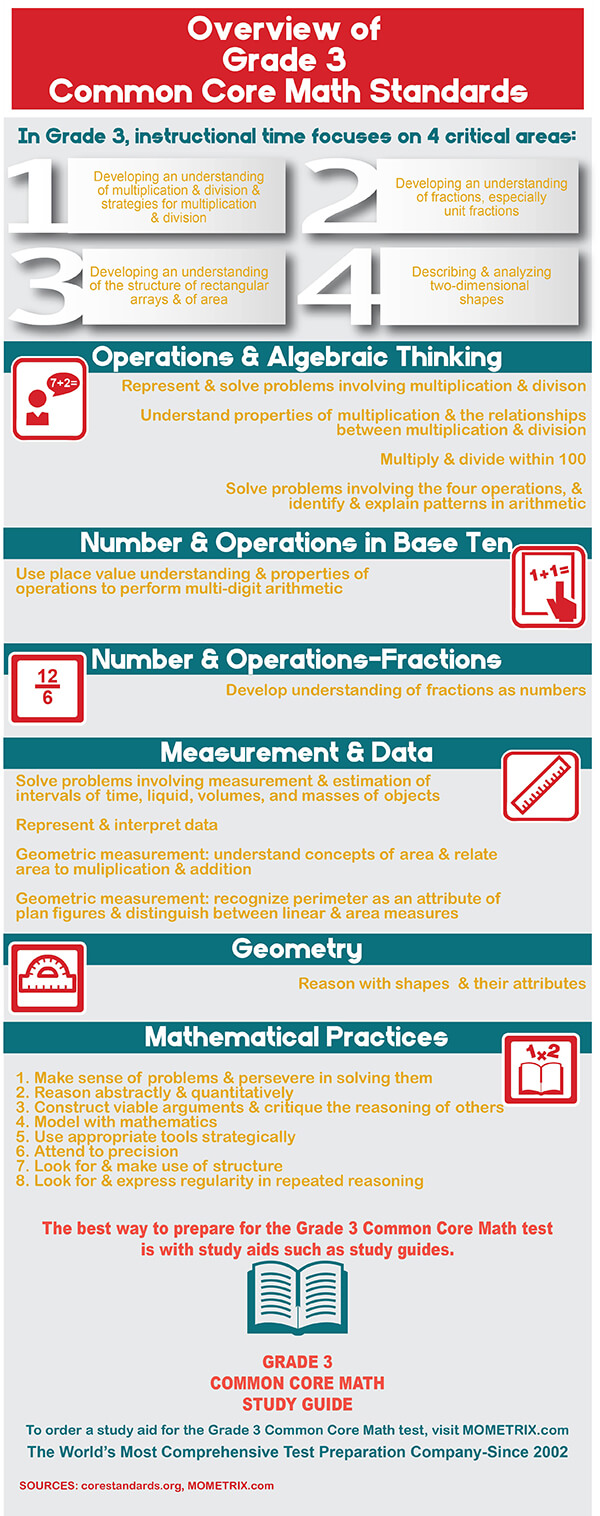Operations and Algebraic Thinking
1. Interpret 6 * 4 in a real world context.
- A family with 4 children has a total of 6 people in it.
- There are 6 cookies, and you eat 4 of them.
- You buy 6 binders for $4 each.
- You have $6, and your mom gives you $4 more.
2. Interpret 24 / 8 in a real world context.
- A total of 24 slices of pizza are divided among 8 hungry people.
- There are 24 houses, and each has 8 windows.
- You have 24 baseball cards, and you buy 8 more.
- Your vacation lasts 8 days, and each day has 24 hours.
3. Ms. Nelson evenly distributes 32 crayons to 8 kindergarteners. How many crayons does each student get?
- 3 crayons
- 4 crayons
- 6 crayons
- 8 crayons
4. Calculate the missing number in 4 x ? = 20.
- 4
- 5
- 6
- 7
Numbers and Operations in Base Ten
5. Round 437 to the nearest ten.
- 400
- 430
- 440
- 500
6. Calculate 381 + 54.
- 335
- 435
- 721
- 921
Numbers and Operations Fractions
7. Which fraction is represented by the darkly shaded area below?

- 1/5
- 4/5
- 5/4
- 5/1
8. Which point represents the fraction 1/4 on the number line below?

- Point A
- Point B
- Point C
- Point D
Measurement and Data
9. Karen takes a 30-minute lunch break starting at 12:15. At what time should she come back from her lunch break?
- 12:30
- 12:35
- 12:40
- 12:45
10. A penny has a mass of about 3 grams. What is the approximate mass of 6 pennies?
- 9 grams
- 12 grams
- 15 grams
- 18 grams
Answers and Explanations
Operations and Algebraic Thinking
1. C: You can think of 6 4 as six groups of four objects. If you buy 6 binders for $4 each, then the total amount of money you spend is $4 + $4 + $4 + $4 + $4 + $4, which is six groups of $4.
2. A: You can think of 24 / 8 as equally dividing 24 objects into eight groups. If 24 slices of pizza are divided between 8 people, then you have to divide the slices into eight groups.
3. B: There are 32 crayons that are evenly divided among 8 students. Therefore, you can find number of crayons each student gets by dividing 32 by 8. The result is 4 crayons each.
4. B: Use trial-and-error to find a number that you can multiply by 4 to get 20. Since 4 1 means four groups of one object, 4 1 = 4. Try using other numbers for missing number.
4 2 = 8
4 3 = 12
4 4 = 16
4 5 = 20
Therefore, the missing number is 5.
Numbers and Operations in Base Ten
5. C: To round to the nearest ten, first look at the digit in the tens place, which is a 3. Thus, if you round 437 down, the 3 will stay the same, and the answer will be 430. Conversely, if you round it up, the 3 will go up to a 4, and the answer will be 440. Finally, look at the number after the 3, which is a 7. Since it is greater than 5, you should round up. Therefore, the answer is 440.
6. B: Set up the addition vertically, making sure to line up the digits by place value.
381
+ 54
435
Numbers and Operations Fractions
7. A: A fraction 1/b can be represented as a whole partitioned (or divided) into b equal parts. For example, if a figure is divided into 2 equal parts, then each part represents 1/2 of the whole. Notice that the rectangle in the problem is divided into 5 equal parts and one of those parts is shaded. Therefore, it represents the fraction 1/5.
8. B: If you partition (or divide) the space between 0 and 1 on a number line into b equal parts, then each part has size 1/b, and the first division to the right of zero represents the point 1/b. For example, if you divide the space between 0 and 1 on a number line into three equal parts, then each part has size 1/3 and the first endpoint represents the point 1/3.
Therefore, to find 1/4, divide the space between 0 and 1 on a number line into four equal parts. The first endpoint represents 1/4.
Measurement and Data
9. D: To calculate when her lunch break finishes, add 30 minutes to the time it starts, 12:15. Since we know that 15 + 30 = 45, the correct answer is 12:45.
10. D: Since each penny has a mass of about 3 grams, you can find the total mass of 6 pennies by adding 3 + 3 + 3 + 3 + 3 + 3. In other words, you have to multiply 3 6. Thus, the total mass is 18 grams.



